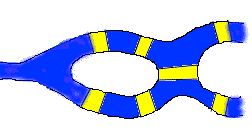NODE WITH ZERO EDGES: AN EVEN NODE (SINCE ZERO IS AN EVEN NUMBER)
*
* *
|
|
* * (UNCONNECTED/CONNECTED)
* * *
/ \ \
/ \ \
*-----* *-----* * *
* * * * * * *-----*
|
|
* * *-----* *-----* *-----*
* * *---* *---* *---*
|\ |\ |\ | |\ /|
| \ | \ | \ | | \ |
| \ | \ | \| |/ \|
*---* *---* *---* *---* Now, evenness of nodeshas an advantage in one sense, and a disadvantage om another. The vast
mathematical field of TOPOLOGY began with the work of Swiss mathematician, Leonhard Euler (1707-
1783), in a GRAPH problem about CROSSING every the Könisberg Bridge network across a river
with an Island in between. How to traverse all bridges without crossing one bridge twice? (This
problem was propounded by German philosopher, Immanuel Kant (1724-1804), and his friends, who
often drank beer at a table facing the river.)
Now, evenness of nodeshas an advantage in one sense, and a disadvantage om another. The vast
mathematical field of TOPOLOGY began with the work of Swiss mathematician, Leonhard Euler (1707-
1783), in a GRAPH problem about CROSSING every the Könisberg Bridge network across a river
with an Island in between. How to traverse all bridges without crossing one bridge twice? (This
problem was propounded by German philosopher, Immanuel Kant (1724-1804), and his friends, who
often drank beer at a table facing the river.)Please note that it forms a graph with 3 NODES with 3 EDGES each and 1 NODE with 5 EDGES -- A TOTAL OF 4 ODD NODES. Euler PROVED THAT ANY GRAPH WITH MORE THAN TWO ODD NODES CANNOT BE TRAVERSED WITHOUT TRAVERSING ONE PATH TWICE. Hence, the Könisberg Bridge Network could not be traversed without crossing one bridge twice.
So, transversality (drawing with out raising marker) requires ONLY 2 ODD NODES; unicursality (transversality, ending up at the starting point) requires NO ODD NODES. But the disadvantage of this is that the graph is not planar, since the crossing lines create a problem. For example, Technological importance: planar graphs make possible printed circuits on microchips in computers. (Wires crossing with give rise to undesirable capacitance effects.)
The planar aspect is encapsulated in one of the most important results in graph theory, Kuratowski's theorem: a graph is planar iff it contains no subgraph homeomorphic to K5 (the complete graph on five vertices) or K3,3 (the bipartite graph having three vertices in each vertex set). A Corollary states that a graph is planar iff it contains no subgraph contractible to K5 or K3,3 -- sometimes called "Kuratowski graphs". (The Graphs.)
The star graph if, of course, the graph kids drawn without lifting a pencil from the paper. The other graph often appears in a trick problem about three houses (upper nodes) and a water department and gas department and electric power plant (lower nodes). Problem: Can these houses be connected to these three sources of enery without their lines crossing? No.